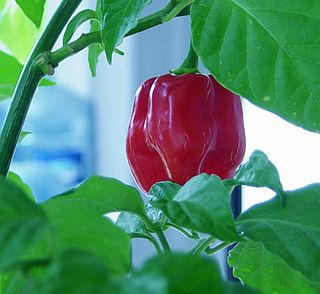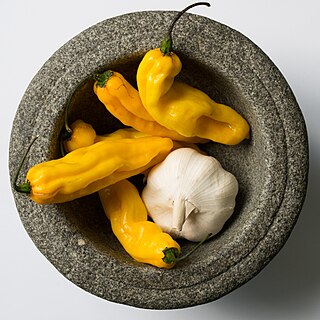
The Scoville scale is a measurement of the pungency of chili peppers, as recorded in Scoville Heat Units (SHU), based on the concentration of capsaicinoids, among which capsaicin is the predominant component. The scale is named after its creator, American pharmacist Wilbur Scoville, whose 1912 method is known as the Scoville organoleptic test. The Scoville organoleptic test is the most practical method for estimating SHU and is a subjective assessment derived from the capsaicinoid sensitivity by people experienced with eating hot chilis.

Chili peppers, from Nahuatl chīlli, are varieties of the berry-fruit of plants from the genus Capsicum, which are members of the nightshade family Solanaceae, cultivated for their pungency. Chili peppers are widely used in many cuisines as a spice to add "heat" to dishes. Capsaicin and related compounds known as capsaicinoids are the substances giving chili peppers their intensity when ingested or applied topically. Other varieties of capsicum include bell peppers, but while chili peppers are pungent, bell peppers are not.

Scotch bonnet is a variety of chili pepper named for its resemblance to a tam o' shanter hat. It is ubiquitous in West Africa as well as the Caribbean. Like the closely related habanero, Scotch bonnets have a heat rating of 100,000–350,000 Scoville units. For comparison, most jalapeño peppers have a heat rating of 2,500 to 8,000 on the Scoville scale. However, completely sweet varieties of Scotch bonnet called cachucha peppers are grown on some of the Caribbean islands.

Dave's Gourmet is a company notable for creating and introducing Dave's Insanity Sauce, which formerly held the title of "world's hottest sauce." The sauce is widely distributed through gourmet hot sauce boutiques and online hot-sauce sites.

Hot sauce is a type of condiment, seasoning, or salsa made from chili peppers and other ingredients. Many commercial varieties of mass-produced hot sauce exist.

Phall, also spelt as fall, faal, phaal, phal or fal, is a curry which originated in the Bangladeshi-owned curry-houses of Birmingham, England and has also spread to the United States. It is not to be confused with the char-grilled, gravyless, finger food phall from Bangalore.

Capsicum chinense, commonly known as a "habanero-type pepper", is a species of chili pepper native to the Americas. C. chinense varieties are well known for their unique flavors and many have exceptional heat. The hottest peppers in the world are members of this species, with Scoville Heat Unit scores of over 2 million. Some taxonomists consider them to be part of the species C. annuum, and they are a member of the C. annuum complex; however, C. chinense and C. annuum pepper plants can sometimes be distinguished by the number of flowers or fruit per node – two to five for C. chinense and one for C. annuum – though this method is not always correct. The two species can also hybridize and generate inter-specific hybrids. It is believed that C. frutescens is the ancestor to the C. chinense species.

The Red Savina pepper is a cultivar of the habanero chili, which has been selectively bred to produce spicier, heavier, and larger fruit, ultimately more potent than its derivative.

The Scotch bonnet is a medium-sized to large species of sea snail, a marine gastropod mollusk in the subfamily Cassinae, the helmet shells and bonnet shells. The common name "Scotch bonnet" alludes to the general outline and color pattern of the shell, which vaguely resemble a tam o' shanter, a traditional Scottish bonnet or cap. The shell is egg-shaped and fairly large, 2 to 4 inches in maximum dimension, with a regular pattern of yellow, orange or brown squarish spots. The surface sculpture of the shell is highly variable: the surface can be smooth and polished, have grooves, be granulated, or even be nodulose on the shoulder of the whorls.
The scotch bonnet is a variety of chili pepper.

Dundicut peppers are a variety of small, round, dark red chili peppers grown in Sindh, in Pakistan, Sikkim in India and Ilam in Nepal. They are a cultivar of either Capsicum frutescens or Capsicum annuum and are also known in Asia as gol lal mirch. Sold dried, Dundicuts are similar in size and flavor to Scotch bonnet peppers, but are not as hot, and are of a different species.

The Naga Viper pepper is a hot chili pepper. In 2011, it was recorded as the "World's Hottest Chili" by the Guinness World Records with a rating of 1,382,118 Scoville Heat Units (SHU), but was surpassed in SHU by the current world record holder the Carolina Reaper in 2017.

The Trinidad Moruga scorpion is a chili pepper native to the village of Moruga, Trinidad and Tobago. It is one of the spiciest chilies in the world. In 2012, New Mexico State University's Chile Pepper Institute identified the Trinidad Moruga scorpion as the hottest chili at that time, with heat of 1.2 million Scoville heat units (SHUs). In 2017 according to Guinness World Records, the hottest pepper was the Carolina Reaper, with 1.6 million SHU.

The Carolina Reaper is a cultivar of the Capsicum chinense plant. Developed by US breeder Ed Currie, the pepper is red and gnarled, with a bumpy texture and small pointed tail. In 2013, Guinness World Records declared it the hottest chili pepper in the world, surpassing the previous record holder, the Trinidad Scorpion "Butch T".

The ghost pepper, also known as bhut jolokia, is an interspecific hybrid chili pepper cultivated in Northeast India. It is a hybrid of Capsicum chinense and Capsicum frutescens.

Madame Jeanette is a chili pepper cultivar of the species capsicum chinense, originally from Suriname.

The habanero is a hot variety of chili. Unripe habaneros are green, and they color as they mature. The most common color variants are orange and red, but the fruit may also be white, brown, yellow, green, or purple. Typically, a ripe habanero is 2–6 centimetres long. Habanero chilis are very hot, rated 100,000–350,000 on the Scoville scale. The habanero's heat, flavor and floral aroma make it a popular ingredient in hot sauces and other spicy foods.

Scotch Bonnet Island is a small island in Lake Ontario. It is part of Prince Edward County, Ontario, Canada.

Scotch Bonnet Ridge is a geologic ridge that crosses the Canada-United States border, in Lake Ontario, south of Prince Edward County. Scotch Bonnet Island and Nicholson Island lie off the shore of Prince Edward County.

Especially among growers in the US, the UK, and Australia, there has been a competition since the 1990s to grow the hottest chili pepper. Chili pepper species and cultivars registering over 1,000,000 Scoville Heat units (SHU) are called "super-hots".


















